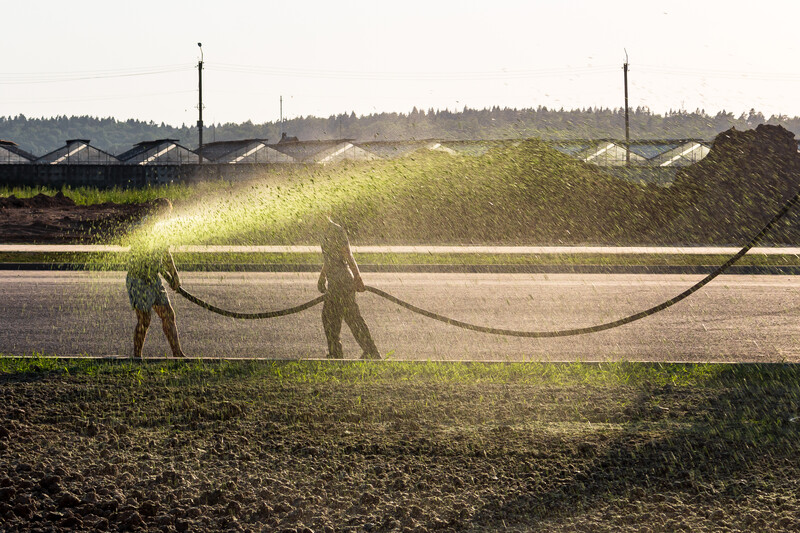- AppliancesElectriciansHVACLandscapingLocksmithPest ControlPlumbingRenovationRoofingT V RepairAll Home Improvement
- Car AccidentClass ActionCorporate LawCriminal DefenseDivorce LawEmployment LawFamily LawFinancial LawLegal AidMedical Injury LawyersMedical MalpracticeReal Estate LawWater Fire RestorationAll Legal
- InvestmentRetirementAll Finance
- Animal InsuranceAutoGeneral InsuranceHealth PolicyHome RentersAll Insurance
- DentalHealth SpecialistsAll Medical
- Animal CareVeterinaryAll Pets
- Auto GlassTowingAll Automotive
What Is Hydroseeding?

Few things are more inviting than lush green grass, but before you run barefoot across the lawn of your dreams, you’ll need to plant it.
Read More Landscaping Articles
If you want to get that seed down quickly, you may be thinking about hydroseeding. However, before you begin, you might want to consider the pros and cons of this modern planting method.
Hydroseeding, which may also be referred to as hydro mulching or hydraulic mulch seeding, is an all-in-one planting method that involves spraying a grass seed slurry over bare ground. This spray-on grass seed mixture typically includes:
- Grass seeds
- Water
- Wood-fiber mulch
- Lime
- Fertilizer
- Bio-stimulants
- Green dye
Hydroseeding may also be used to plant wildflowers, oats and other ground covers.
How Does the Process Work?
To begin, a custom blend of grass seeds is mixed with water, mulch and nutrients to form a wet slurry. A green tracking dye, which fades over time, may also be added to ensure no area is missed when seeding and give the space a more attractive appearance prior to germination. The hydroseeding slurry is loaded into the tank of a hydroseeder, which typically includes an agitator to keep the slurry evenly blended for better application. With a high-pressure hose, the seed mixture is then sprayed onto soil that’s been cleared, leveled and tested.
For small, residential yards, hydroseeding may be done using a small pressure sprayer. For large areas, such as golf courses, hydroseeding is typically done using a truck to ensure more even coverage.

Conventional seeding is typically done by hand using either a walk-behind or handheld spreader. Seed may be distributed in precise rows using a drop spreader or disbursed in a fanlike pattern using a broadcast spreader. It often takes multiple passes to achieve the best results, which can be time-consuming.
Conventional seeding and hydroseeding are similar in many ways. Both methods require the same ground preparation steps before sowing, including debris removal, soil testing and land leveling. They should also be done at the same time of year, which can vary by location, current weather conditions and the type of grass being planted. In many climates, spring and fall are ideal for planting.
However, there are notable differences between hydroseeding and conventional methods. Because lawn seed is sprayed on during the hydroseed process, this method is much more efficient than traditional hand seeding. Additionally, grass seed, fertilizer and mulch are all applied at the same time, whereas during conventional seeding, these essentials are typically applied in multiple steps. Hydroseeding also lets homeowners design a custom blend of grasses to achieve a desired aesthetic and prioritize characteristics, such as heat, drought or disease resistance.
Hydroseeded lawns also have several other advantages over those sown through conventional methods, including:
- More uniform coverage
- Rapid seed germination
- Fewer initial maintenance requirements
- Better moisture retention
- Easier planting in rough or uneven terrain
- Enhanced soil erosion control, especially on steep slopes
- Reduced weed growth
Hydroseeding's main disadvantage is its cost, as it's considerably more expensive than hand-seeding methods. However, it's substantially less expensive than laying sod.
More Related Articles:
- Spring Lawn Maintenance: 7 Tasks for Your To-Do List
- 6 Ways to Conserve Water Without Sacrificing Your Lawn
- How Much Will You Pay for Lawn Care Services?
- Everything You Need to Know About Lawn Aeration
- 11 Ways to Bring a Damaged Lawn Back to Life
Can You Hydroseed Yourself, or Do You Need to Hire a Pro?
Amateur landscapers and budget-conscious homeowners may want to try their hand at DIY hydroseeding. Many community garden centers, hardware stores and online retailers sell kits that can be sprayed on using a standard garden hose. If you want a customized blend, you can even mix up a hydroseed grass seed spray yourself, using the grass seed, fertilizer and mulch of your choice. Hydroseeding machines can typically be rented from your local lawn and garden store.
However, DIY hydroseeding may not deliver the same high-quality results that a pro can offer. Hydroseeding professionals can help you choose the right hydroseed grass mixture for your climate and soil. Professional application can also ensure even coverage, particularly if you’re planting a large area. When hiring a hydroseeding specialist, be sure to select a reputable contractor who specializes in this technique. Some states may require licensing, so check with your state's agricultural board before choosing a provider.
Elocal Editorial Content is for educational and entertainment purposes only. Editorial Content should not be used as a substitute for advice from a licensed professional in your state reviewing your issue. Systems, equipment, issues and circumstances vary. Follow the manufacturer's safety precautions. The opinions, beliefs and viewpoints expressed by the eLocal Editorial Team and other third-party content providers do not necessarily reflect the opinions, beliefs and viewpoints of eLocal or its affiliate companies. Use of the Blog is subject to the
Website Terms and Conditions.The eLocal Editorial Team operates independently of eLocal USA's marketing and sales decisions.



